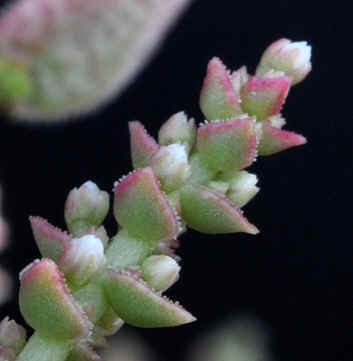It is easy to grow in
normal well drained cactus compost and standard levels of neglect, but it does
not propagate itself in my greenhouse as some species with either adventitious
roots, layering or the rooting of fallen leaves. I have not yet tried to
propagate it, but it should grow from cuttings. But because the leaves are
compacted so close together along the stem and the stem is fragile and weak by
comparison, I think it would need to just be pressed lightly in to silver sand
on the top of the pot, because to make a traditional cutting from it by removing
the leaves from the lower stem would not be possible. I was told my plant
comes from Madagascar, but it does not occur naturally on Madagascar, so if
someone got it there it must have been in cultivation or growing as a garden
escape. There is no reason why it could not have found its way to Madagascar and
of course similar plants grow there as grow in S Africa such as the Aloes. Maybe
I will go to see for myself one day! Gordon Rowley’s book shows a picture of
it with a purple tinge on the leaf surface, although I believe the form I have
is more naturally green. Mine certainly looks a little different but is not
grown in full sun, which perhaps explains the light green colour of the leaves. The plant begins to
show its first flowers about the end of July and continues for weeks on end
filling the greenhouse with this sweet scent.
I think that for such small flowers to produce such a strong and heady
fragrance is surprising. I wish there were more cacti and succulents with
scented flowers, although I know that not everybody likes these sweet jasmine
like scents! But for those who do, this is a plant to look out for. Philip Ed:
Thanks Philip. This report
of a sweet scented Crassula was most interesting. I am familiar with the flowers
of Crassula
sarcocaulis which
have a disgusting smell, so bad I cannot share greenhouse space with it. Luckily
this species is nearly hardy and it can take its chances in a cold frame. So New Year’s resolution is to sniff flowers for their scent, (and especially those in habitat, I may not get another chance and Sclerocactus has scented flowers reported for several species). |



